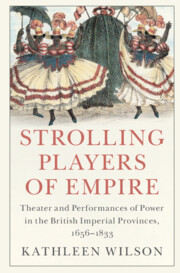 Strolling Players of Empire
Strolling Players of Empire Book contents
- Strolling Players of Empire
- Critical Perspectives on Empire
- Strolling Players of Empire
- Copyright page
- Dedication
- Epigraph
- Contents
- Figures
- Maps
- Acknowledgments
- Abbreviations
- Prologue
- Introduction
- Part I Playing
- Part II Theaters of Empire
- 4 Performances of Freedom
- 5 Blackface Empire: or, the Slavery Meridian
- 6 Zanga’s Colony
- Part III East India Company Peripheries and the History of Modernity
- Book part
- Index
- Plate Section (PDF Only)
5 - Blackface Empire: or, the Slavery Meridian
from Part II - Theaters of Empire
Published online by Cambridge University Press: 11 November 2022
- Strolling Players of Empire
- Critical Perspectives on Empire
- Strolling Players of Empire
- Copyright page
- Dedication
- Epigraph
- Contents
- Figures
- Maps
- Acknowledgments
- Abbreviations
- Prologue
- Introduction
- Part I Playing
- Part II Theaters of Empire
- 4 Performances of Freedom
- 5 Blackface Empire: or, the Slavery Meridian
- 6 Zanga’s Colony
- Part III East India Company Peripheries and the History of Modernity
- Book part
- Index
- Plate Section (PDF Only)
Summary
How did blackness and whiteness figure in the patterns of life and represenation that moved across the eighteenth-century theatrical empire? Performances of blackface characters in colonial environments – in this case of Mungo, the enslaved Black Servant in the comic opera The Padlock – could take the lead in parsing, categorizing and enacting typologies of "darker-skinned" peoples with lasting effects – an embodied form of racial "knowledge" that undergirded the subordination of non-British peoples in the construction of a global laboring class.
Keywords
- Type
- Chapter
- Information
- Strolling Players of EmpireTheater and Performances of Power in the British Imperial Provinces, 1656–1833, pp. 251 - 312Publisher: Cambridge University PressPrint publication year: 2022
